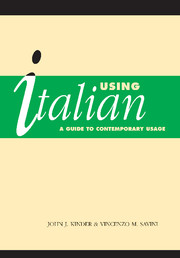Book contents
- Frontmatter
- Contents
- Preface and acknowledgments
- Abbreviations
- 1 Varieties of language
- WORDS AND THEIR MEANINGS
- THE CLAUSE – combining words
- 14 Gender
- 15 Number
- 16 Pronouns
- 17 Comparison
- 18 Word order
- 19 Negation
- 20 Periphrases
- 21 Verbs of movement
- 22 Auxiliary verbs in compound tenses
- 23 The passive
- 24 Reflexives and impersonals
- THE SENTENCE – combining clauses
- TEXTS AND THEIR STRUCTURE
- Bibliography
- Italian word index
- Grammar index
24 - Reflexives and impersonals
Published online by Cambridge University Press: 05 June 2012
- Frontmatter
- Contents
- Preface and acknowledgments
- Abbreviations
- 1 Varieties of language
- WORDS AND THEIR MEANINGS
- THE CLAUSE – combining words
- 14 Gender
- 15 Number
- 16 Pronouns
- 17 Comparison
- 18 Word order
- 19 Negation
- 20 Periphrases
- 21 Verbs of movement
- 22 Auxiliary verbs in compound tenses
- 23 The passive
- 24 Reflexives and impersonals
- THE SENTENCE – combining clauses
- TEXTS AND THEIR STRUCTURE
- Bibliography
- Italian word index
- Grammar index
Summary
The Italian reflexive has many different functions, some of which are not paralleled in English. Reflexive verbs always take the auxiliary essere, except in the case mentioned in section 24.1. The reflexive pronoun is omitted when the reflexive verb is an infinitive depending on fare or lasciare, e.g.:
Lo hanno fatto pentire (not pentirsi) delle sue parole.
They made him regret his words.
Direct reflexives
Most transitive verbs can be used reflexively when subject and object coincide. Direct reflexives are usually defined as taking unstressed reflexive pronouns (before the verb) and essere in compound tenses. However, they may also take stressed pronouns (cf. chapter 16): these follow the verb, and avere is used (cf. section 22.6), e.g.:
Mi sono vestito / Ho vestito i bambini (e poi me stesso).
I (got) dressed / I dressed the children (and then myself).
Indirect reflexives
The reflexive pronoun is an indirect object and expresses greater involvement in the action by the subject. This is increasingly common in R1–2. In compound tenses, the past participle agrees with the subject (or with the object, R3):
R1* vulgar or indecent
R1 informal, colloquial
R2 neutral, unmarked
R3 formal, written Italian words and expressions are R2 unless otherwise indicated. See also p. 5.
- Type
- Chapter
- Information
- Using ItalianA Guide to Contemporary Usage, pp. 311 - 318Publisher: Cambridge University PressPrint publication year: 2004



